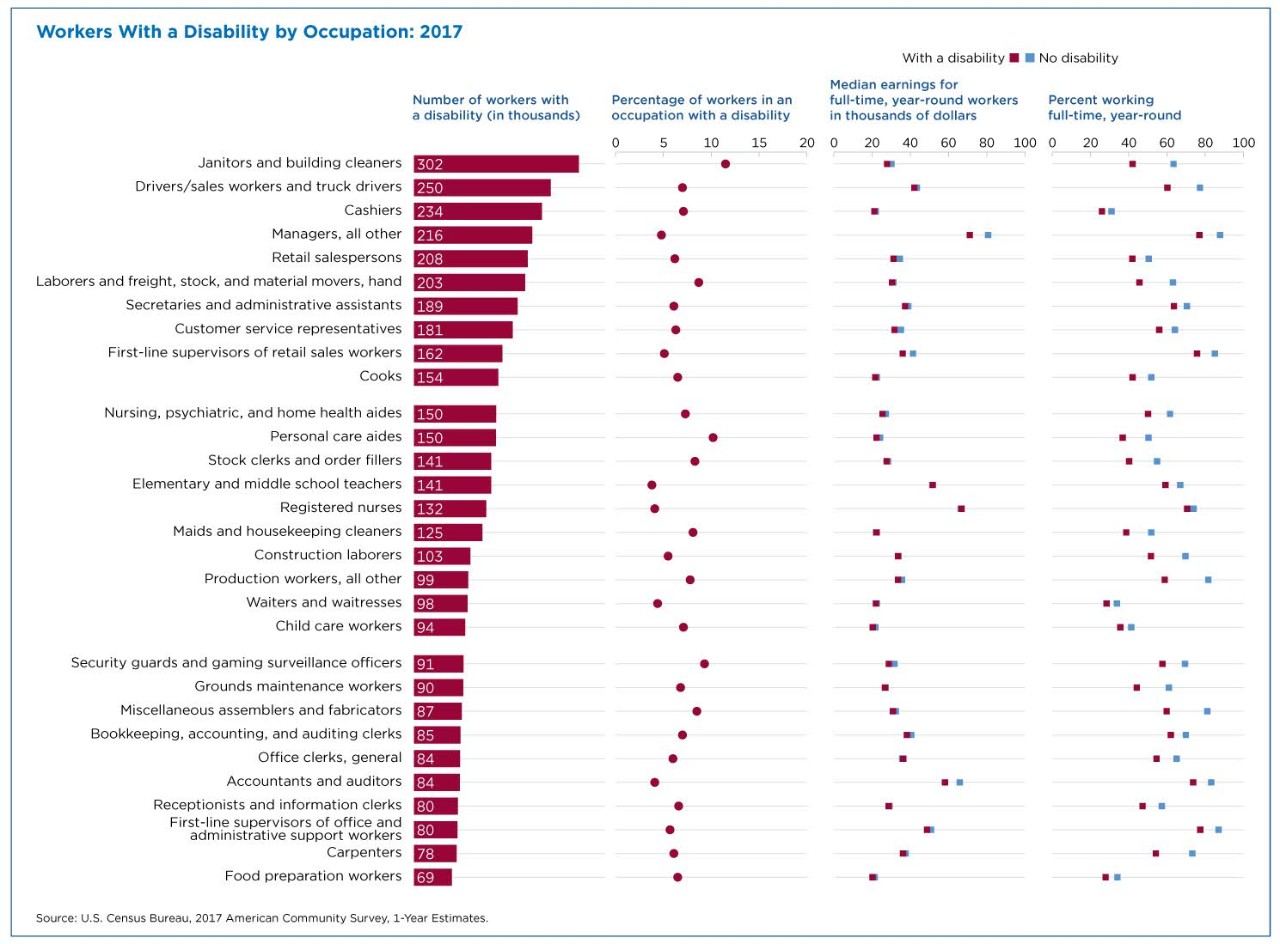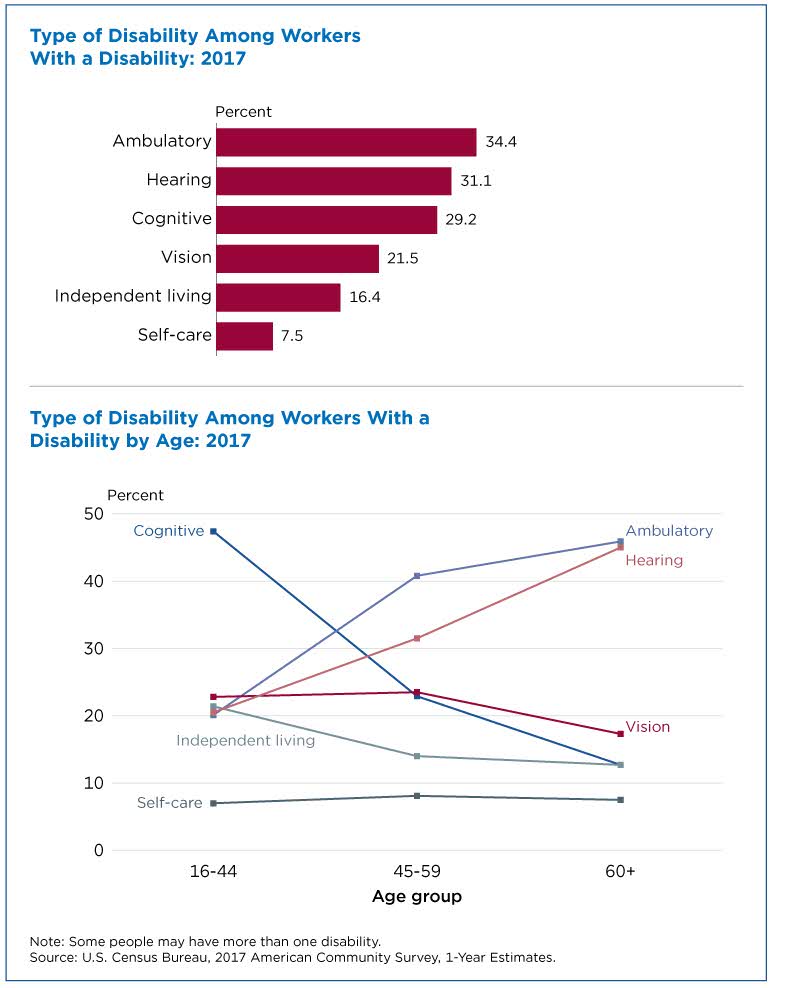In Most Occupations, Workers With or Without Disabilities Earn About the Same
Overall, workers with a disability earn less than workers who do not have a disability.
Yet, depending on the types of work they do, much of the difference in median earnings disappear.
Today, a record 9 million people with a disability work. While these workers, age 16 and older, are spread throughout the labor force, workers with a disability tend to concentrate in certain jobs depending on their age and particular disability.
Among people working similar jobs and schedules, the median earnings for workers with a disability are either very close to, or not different from, earnings for workers with no disability.
The most common occupation for people with a disability is janitors and building cleaners, where about 300,000 workers with disabilities find employment. They make up 11 percent of workers in this occupation.
Other large occupations for workers with disabilities are:
- Drivers/sales workers/truck drivers.
- Cashiers.
- Retail salespersons.
- Laborers and freight, stock and material movers.
Median Earnings and Occupations
As a group, full-time, year-round workers with a disability earn 87 cents for every dollar earned by those with no disability.
However, among people working similar jobs and schedules, the median earnings for workers with a disability are either very close to, or not different from, earnings for workers with no disability.
In fact, accounting for the differential mix of occupations between these workers with or without a disability reduces the overall disparity in median earnings by about half.
A few occupations stand out as exceptions, with notable differences in median earnings between the two groups. These occupations typically have much higher median earnings for people both with a disability and with no disability. These include:
- Chief executives.
- Lawyers.
- Marketing and sales managers.
- Financial analysts.
However, the median earnings for physicians and surgeons, who rank at the top of the earnings list, are no different between those with a disability and those without.
Age may play an important role in masking some earnings differences between workers with a disability and those without. For most occupations, the median age of workers with a disability exceeds that of workers with no disability. Since earnings tend to increase with age, this average age difference also tends to inflate the overall median earnings of workers with a disability relative to those with no disability.
Yet, despite the similarities in median earnings among full-time, year-round workers, people with a disability are less likely to earn a full-time wage. In nearly every occupation, workers with a disability are less likely to work full-time, year-round. So, including all workers regardless of work schedules or occupation increases the overall earnings gap, where workers with a disability earn 66 cents for every dollar than those with no disability earn.
Workers With Disabilities Increase With Age
Workers with a disability make up just 6 percent of working adults, but this figure rises with age. About 4 percent of workers under age 45, 7 percent of workers ages 45-59, and 13 percent of workers age 60 and older have a disability.
Top-ranked occupations for younger workers (ages 16 to 44) with a disability are:
- Cashiers.
- Laborers/freight/ stock/material movers-hand.
- Janitors and building cleaners.
- Customer service representatives.
- Cooks.
- Retail salespersons.
- Stock clerks/order fillers.
- Waiters/waitresses.
Top-ranked occupations for older workers (age 60 and older) with a disability are:
- Driver/sales workers/truck drivers.
- Janitors and building cleaners.
- Secretaries and administrative assistants.
- Retail salespersons.
- Personal care aides.
- Registered nurses.
- First-line supervisors of retail sales workers.
- Cashiers.
- Elementary and middle school teachers.
Defining Disabilities
Ambulatory, hearing and cognitive are the most common difficulties among workers with a disability, which may have an impact on the type of jobs they can get. For younger workers with a disability, cognitive difficulty is the most common, while ambulatory and hearing difficulties are more common among older workers.
In fact, about half of working-age adults with a disability reported they had a health condition that was an impediment for the kinds of work they could perform or the number of hours they could work.
This varies by disability type. People with a hearing disability are more likely to work than people with other disability types.
Higher Concentration in Some Occupations
In addition to janitors and building cleaners, several occupations have more than 10 percent of their workers with a disability. Among them are:
- Dishwashers.
- Crossing guards.
- Refuse and recyclable material collectors.
Occupations with high rates of ambulatory difficulty among workers with a disability include:
- Dispatchers.
- Bus drivers.
- Insurance claims/policy processing clerks.
- Bookkeeping/accounting/auditing clerks.
- Secretaries/administrative assistants.
- Taxi drivers /chauffeurs.
Occupations where about half of workers with a disability had cognitive difficulty include:
- Dishwashers.
- Dining room/cafeteria attendants/bartender helpers.
- Refuse/recyclable material collectors.
- Packers/packagers.
- Waiters/waitresses.
- Food preparation workers.
- Farmers/ranchers/other agriculture managers.
- Police/sheriffs/patrol officers.
- Heavy vehicle/mobile equipment service technicians/mechanics.
- Operating engineers/other construction equipment operators including pile-driver operators.
- Machinists.
- Physicians/surgeons.
About half of workers with a disability in the following occupations had hearing difficulty:
- Farmers/ranchers/other agriculture managers.
- Police/sheriffs/patrol officers.
- Heavy vehicle/mobile equipment service technicians/mechanics.
- Operating engineers/other construction equipment operators including pile-driver operators.
- Machinists.
- Physicians/surgeons.
The statistics in this story are based on Census Bureau analysis of supplementary detailed tables from the American Community Survey.
Related Statistics
Subscribe
Our email newsletter is sent out on the day we publish a story. Get an alert directly in your inbox to read, share and blog about our newest stories.
Contact our Public Information Office for media inquiries or interviews.
-
Business and EconomyWhat is a Business?March 13, 2019More than 76 percent of businesses have no paid employees. They are in nearly every sector of the economy and dominate some industries.
-
Population2020 Census Hiring of Thousands of Workers Ramps UpMarch 12, 2019The decennial census is the nation’s largest civilian mobilization effort and the hiring of temporary workers has already begun.
-
Business and EconomyHow Many Work in Manufacturing?October 04, 2018The Annual Survey of Manufactures shows manufacturing receipts and how many are employed in manufacturing by state and by sector.
-
EmploymentThe Stories Behind Census Numbers in 2025December 22, 2025A year-end review of America Counts stories on everything from families and housing to business and income.
-
Families and Living ArrangementsMore First-Time Moms Live With an Unmarried PartnerDecember 16, 2025About a quarter of all first-time mothers were cohabiting at the time of childbirth in the early 2020s. College-educated moms were more likely to be married.
-
Business and EconomyState Governments Parlay Sports Betting Into Tax WindfallDecember 10, 2025Total state-level sports betting tax revenues has increased 382% since the third quarter of 2021, when data collection began.
-
EmploymentU.S. Workforce is Aging, Especially in Some FirmsDecember 02, 2025Firms in sectors like utilities and manufacturing and states like Maine are more likely to have a high share of workers over age 55.






